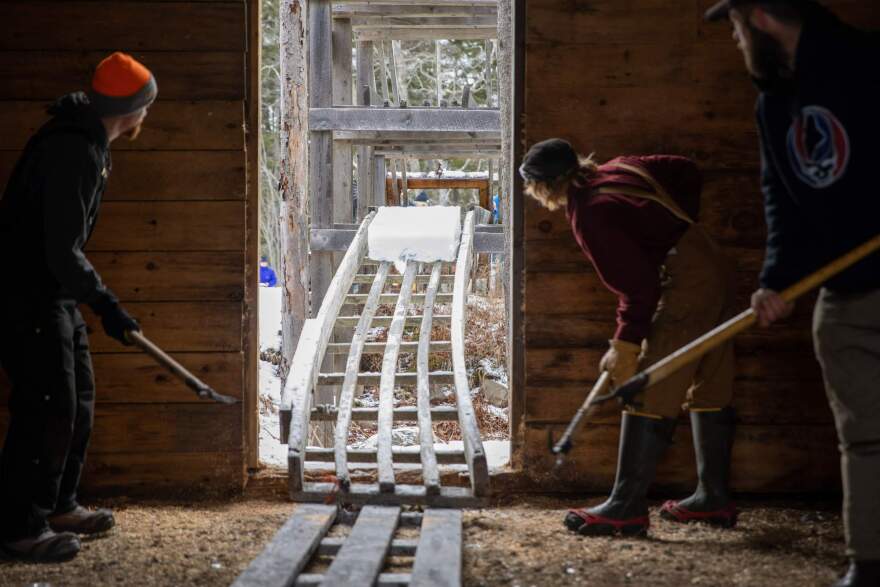Ice harvesting was a thriving industry in 19th century New England. Using large, jagged-toothed saws, workers would cut heavy blocks from frozen rivers, lakes and ponds, pack it in sawdust and sell it around the world. Then came electric refrigeration, and ice-cutting became all but obsolete. But there are still a few places where the tradition is carried on.
WATCH: Ice Harvesting Tradition Lives On In Maine Village
It’s a postcard-perfect winter scene — a small, snow-covered pond framed by tall trees and a rustic barn. Here in South Bristol, Ken Lincoln and several other men are out early in the morning, doing what they learned to do as kids. They’re removing the first blocks of ice from the pond.

Lincoln is the president of the Thompson Ice House Preservation Corp., which operates an on-site museum and sponsors the old-fashioned ice harvest every Presidents Day weekend. He wears thick coveralls and ice grippers on his boots — this is slippery work.
“Every year someone ends up in the pond, but no tragedies. We grab ’em out pretty quick,” he says with a laugh.

First, a checkerboard-style design is carved onto the pond’s surface using a tool called a scribe. Then volunteers use handsaws and ice picks to break off the blocks one row at a time.
People of all ages are encouraged to participate. Nine-year-old Issac Ezzell is helping his father, James, guide the ice blocks along an open channel of water toward the icehouse, where they will be stored.
“I was doing this since I was six,” Issac says, but his father corrects him.
“You did it before you were six. I think we had you here when you were four for your first time,” James Ezell says.

Lincoln himself grew up skating on the pond. He also learned traditional ice harvesting techniques, and when he got older worked for a small commercial ice operation that ended several decades ago. The annual ice harvest is an outgrowth of that.
“If we didn’t do this it would go away and be forgotten. This is one way to keep it a working history,” he says.
By midmorning a crowd has gathered. The 250-pound ice blocks are pushed up a wooden ramp and hoisted by pulley into the icehouse, which is insulated with several inches of sawdust. The ice blocks glide in like giant, high-speed hockey pucks. Energetic “wranglers” dodge the heavy blocks, spear them with long picks and stack them, one layer at a time, until the icehouse is nearly full.
“It’s very scary to watch,” says Karen Pride of Portland. “You can see that if something did not go right it would be very bad.”
Outside, Johanna Gauvreau and Justin Smith of Portland are sitting in heated folding chairs, eating chili and chowder and watching three generations of volunteers take part in the effort. In the past the couple has helped out, but Gauvreau says this year they were concerned about the thickness of the ice.
“It looked a little slippery, a little thin and I don’t have the greatest balance, so we thought we’d just be spectators this year,” she says.

“But supporting the spirit,” Smith says.
This year the ice is about nine inches thick. That’s several inches less than normal, but Lincoln says winter seems to be arriving a little later each year. Still, it’s enough ice to sell to local fishermen and boaters and to save for a popular ice cream social in July.
More importantly, Lincoln says, it’s a way to keep this chapter of New England history frozen in time.















